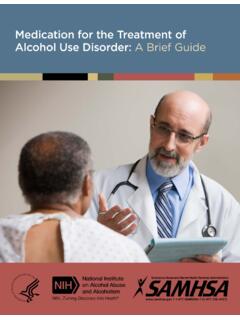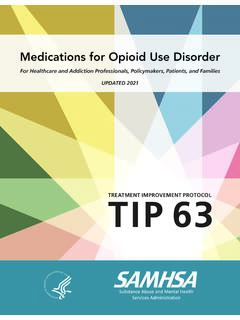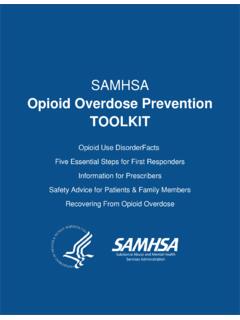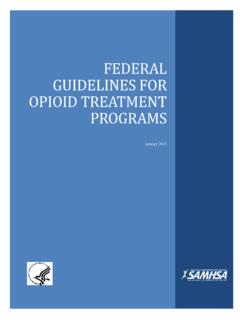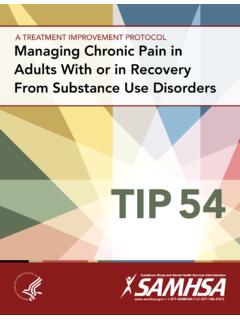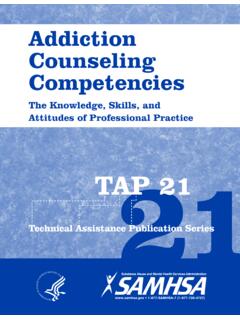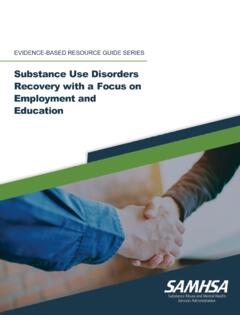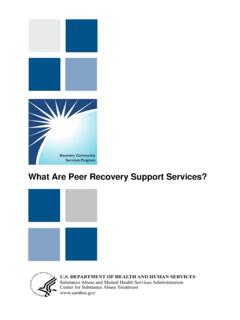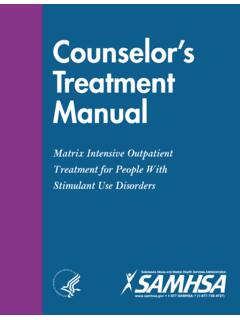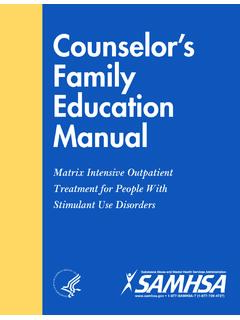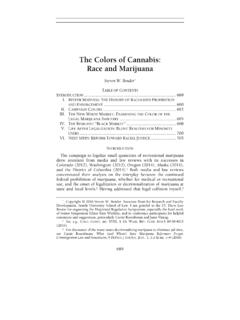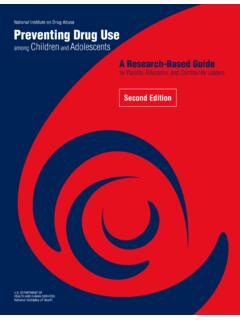Transcription of Student Assistance: A Guide for School Administrators
1 A Guide for School AdministratorsiSTUDENT ASSISTANCEA Guide FOR School ADMINISTRATORSACKNOWLEDGMENTSThis handbook was prepared for the Substance Abuse and Mental Health Services Administration (SAMHSA) by the Department of Psychology, College of Arts and Sciences, University of South Carolina, under contract number HHSS283200700008I/HHSS28342001T. David Wilson served as the Government Project AND CONTRIBUTORSR obert M. Vincent, ; Mark D. Weist, ; Michael L. Dennis, ; Elaine Miller, ; Joni Splett, ; Leslie Taylor, ; Rachel Williamson, ; Erin Riffe, MBA; Cynthia Moreno-Tuohy; Heather Gotham, ; Jason Kilmer, ; Jim Campain; Joanne Burkholder; Ken Winters, ; Shannon Balilie; Paul D.
2 Views, opinions, and content of this publication are those of the authors and do not necessarily reflect the views, opinions, or policies of SAMHSA or DOMAIN NOTICEAll material appearing in this handbook is in the public domain and may be reproduced or copied without permission from SAMHSA. Citation of the source is appreciated. However, this publication may not be reproduced or distributed for a fee without the specific, written authorization of the Office of Communications, ACCESS AND PRINTED COPIESThis publication may be downloaded or ordered at or by calling SAMHSA at 1 877 SAMHSA 7 (1 877 726 4727) (English and Espa ol).
3 RECOMMENDED CITATIONS ubstance Abuse and Mental Health Services Administration: Student Assistance: A Guide for School Administrators . SAMHSA Publication No. PEP19-03-01-001. Rockville, MD, Substance Abuse and Mental Health Services Administration, OFFICED ivision of Systems Development, Center for Substance Abuse Prevention, Substance Abuse and Mental Health Services Administration, 5600 Fishers Lane, Rockville, MD 20857. SAMHSA Publication No. PEP19-03-01-001. Printed in Overview of Student Continuum of Student Support Student Assistance Programs (SAPs).
4 What Is a Student Assistance Program?.. How Do SAPs Function in Schools?.. Links to Academic and Behavioral of Effective Student Assistance Orientation for Principals and 1. School Board 2. Staff Program Internal Referral Problem-Solving Team and Case Direct Services to Cooperation and Integration with Other School -Based Program Evaluation and for Integration with Other School School School Violence Prevention and Safety School Selection of Service Delivery Quality for Strategic Prevention Understanding Risk and Protective Adolescent 1145567991010111112131415161717171818192 22227272831333537 CONTENTSA Guide for School Administrators1 OVERVIEW OF Student ASSISTANCE
5 The purpose of this Guide is to provide School leaders and Administrators with key information regarding Student assistance services. In this Guide , we review aspects of providing Student assistance, including connections to existing School , substance use, and mental health initiatives; key components of effective programming; considerations for implementation; and planning for success. Information provided in this Guide will assist School leaders in beginning and/or improving Student assistance services and provide guidance on more comprehensive resources for this critically important the most universal, natural setting for children and adolescents, schools are uniquely positioned to provide programs and services that promote Student health and optimal wellness while removing barriers to active learning.
6 In reality, almost every Student will face some level of difficulty or be at risk for alcohol and substance use, violence, or mental health problems at least one time during his or her School career. Students reports of these behaviors raise concerns not only for their health and well-being but also for their academic progress and outcomes later in these statistics: Alcohol is the substance of choice among our nation s young people; while they drink less frequently than adults, youth consume more alcohol when they In 2018, more adolescents ages 12 to 17 used alcohol for the first time in the past year ( million) compared to marijuana ( million).
7 2 Approximately 4 percent of youth ages 12 to 17 experienced substance use disorders in the past Assistance2 In 2018, percent of youth ages 12 to 17 had a Major Depressive Episode (MDE) during the past year, and 10 percent had a past-year MDE with severe Five youths under the age of 20 complete suicide every are also exposed to violence at School , at home, and in the community at alarming rates: In 2016, an estimated 676,000 children were abused and One in 4 children comes from a home affected by substance use An estimated million violence-related crimes occurred in schools during the 2015 2016 School shootings, which have been documented in the United States since 1966,9 occur across the country every year, with devastating implications for youth and their families.
8 Since 1996, two-thirds of the shooters were between the ages of 13 and 18, approximately 1 in 6 were 14 years old, and 9 in 10 were with other violence-related events, these tragedies highlight the increasing risk violence poses to today s youth and the vital role of schools and community systems in monitoring, assisting, and supporting youth . These statistics underscore the need for Student assistance services to provide prevention, early intervention, treatment, and recovery support to protect students from harm, support positive decision-making, and remove barriers to learning.
9 If such problems are not adequately addressed, youth are more likely to experience poor outcomes and economic costs youth who use alcohol or other substances and/or engage in violent and delinquent behaviors score 30 to 50 points lower than youth with low to moderate levels of these behaviors on reading and math achievement ,13 Of these students, 50 percent drop out of high School and face high rates of incarceration, criminality, unemployment, suicidality,14,15,16 and ,18,19 The Substance Abuse and Mental Health Services Administration (SAMHSA) supports many initiatives to prevent substance use and mental health issues among youth , including:National Prevention Week an annual national health observance in which schools and communities can participate to raise awareness of substance use disorders and mental health issues.
10 Now is the Time Project AWARE a grant program that supports the training of School personnel and other adults who interact with youth in both School settings and communities to detect and respond to mental illness in children and youth , including how to encourage adolescents and their families experiencing these problems to seek treatment. Talk. They Hear You. a free mobile app that helps parents practice broaching the topic of alcohol with their kids, learn questions to ask, and get ideas to keep the conversation Suicide: A Toolkit for High Schools a publication to assist high schools and School districts in designing and implementing strategies to prevent suicide and promote behavioral a free mobile app that provides information about the warning signs of a child being bullied or engaging in bullying, as well as prevention tips, conversation starters for meaningful discussion between parents and kids.
